
Welcome to another installment of DIY madness for my ER34 Skyline. This time around we’re diving deep into the Nissan’s suspension setup, with the hope of extracting more of its handling potential.
Truth be told, Project Rough has always handled quite well, both on spirited drives in the mountains and on track. It seems like forever ago, but one of the first things I changed after bringing my GT-T home from an epic 3,000km journey from Okinawa, was to replace the blown-out and overly stiff coilovers. My good friend at Tuner Concepts whipped up a custom package for that included adjustable coilovers, a selection of spring sets (10kg, 8kg, and 6kg), lower control arms front and rear, and upper control arms out back.
I’ve made subtle tweaks over time and have been pretty satisfied with the car’s overall setup so far, but the evil man that sits next to my left ear kept telling me to do more. Thus, during a late-night dive into the rabbit hole that is the internet, I discovered a forum where a Japanese guy explained how he weighed his car using bathroom scales.

It was a pretty simplistic method of jacking his car up, sitting the corners on bricks to make a level platform, and moving the scales around to each corner. There were a few things I noticed that could have done to improve the accuracy of the method, but it was this story that got the evil man excited. He stood up, got real close to my ear, and uttered two words: Corner balance.
CHAPTER TWO
Beware Of Traps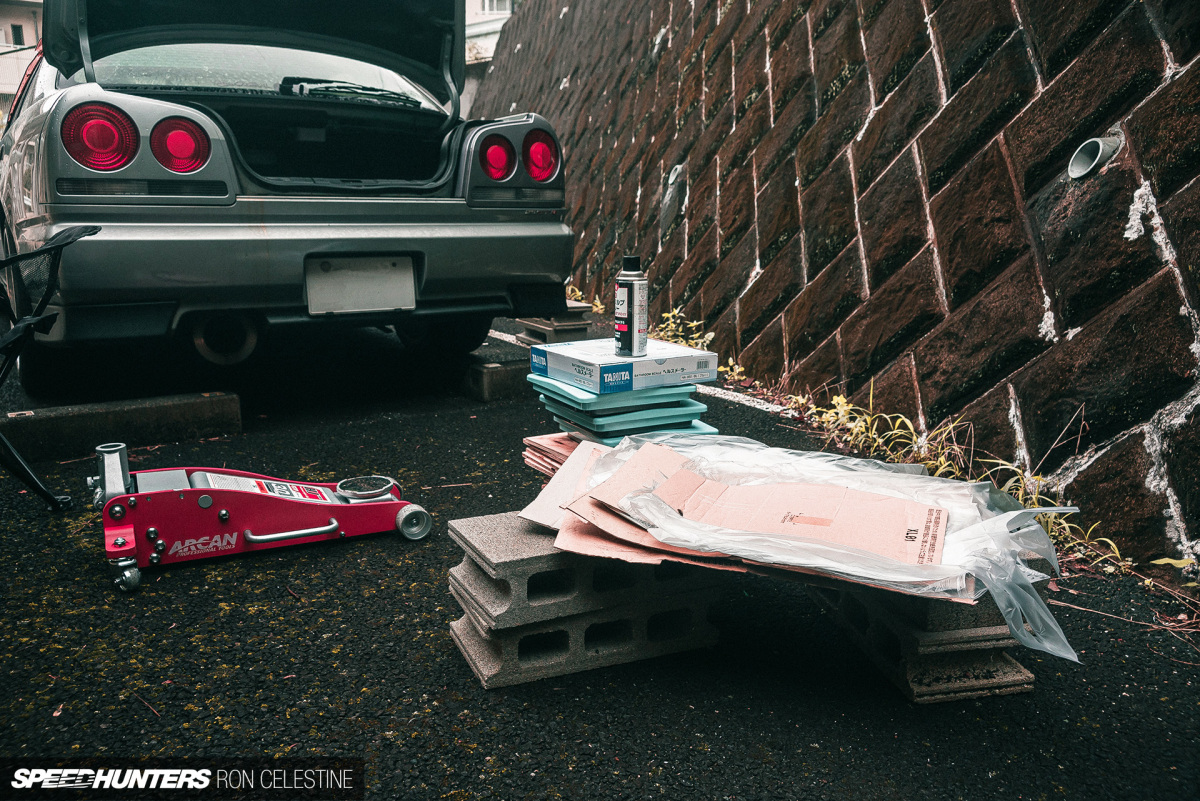
The next few weeks were spent planning how, or even if, this would be something I could pull off at home.

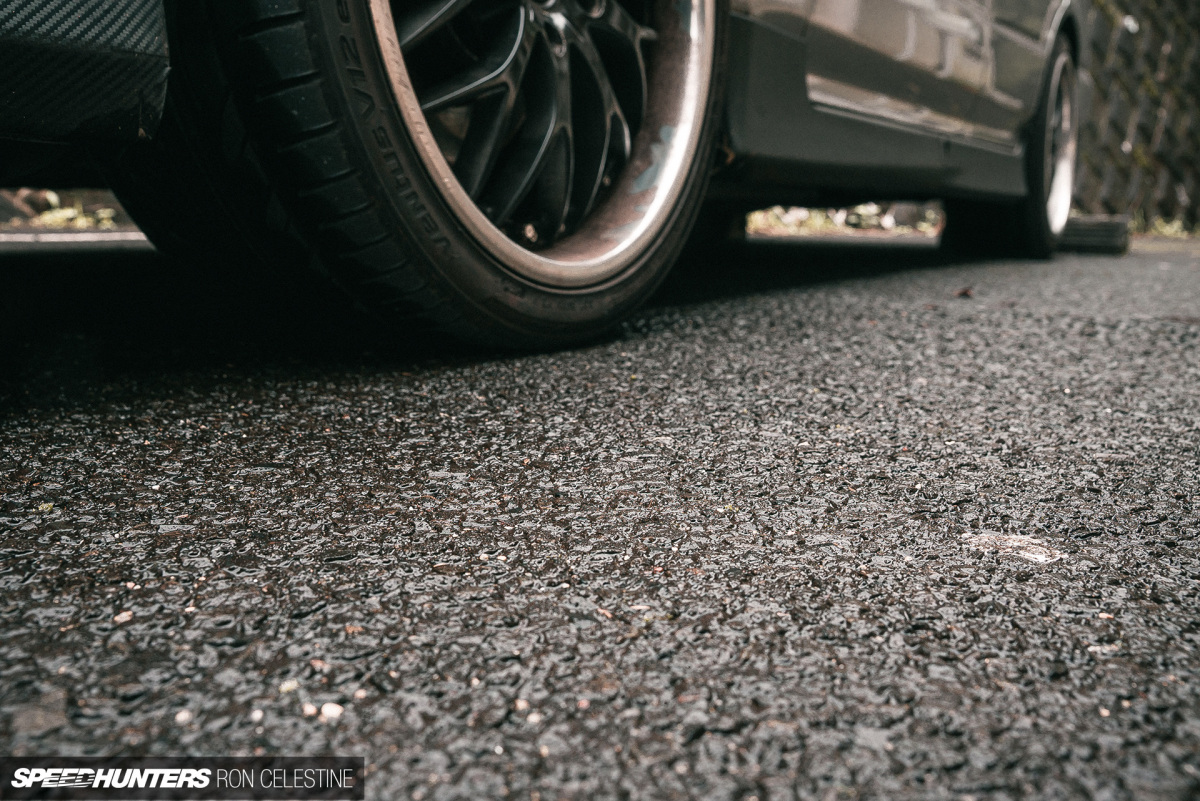
When corner balancing your car, you want to be on a perfectly flat surface. From the photos above, you might think that my parking space is indeed flat, but in reality the surface is pretty rough and quite uneven in some places.
Then there’s the problem of using a jack to lift your car onto a platform – in this case bricks. When you jack your car up and lower it onto a non-movable surface, your suspension remains bound up. It may not seem like a big deal, but if you were to change any geometry in this state – let’s say altering the toe or camber angles – when your suspension finally reached its relaxed state, your measurements would be completely off.
If I could figure ways around these problems, perhaps it could be done…

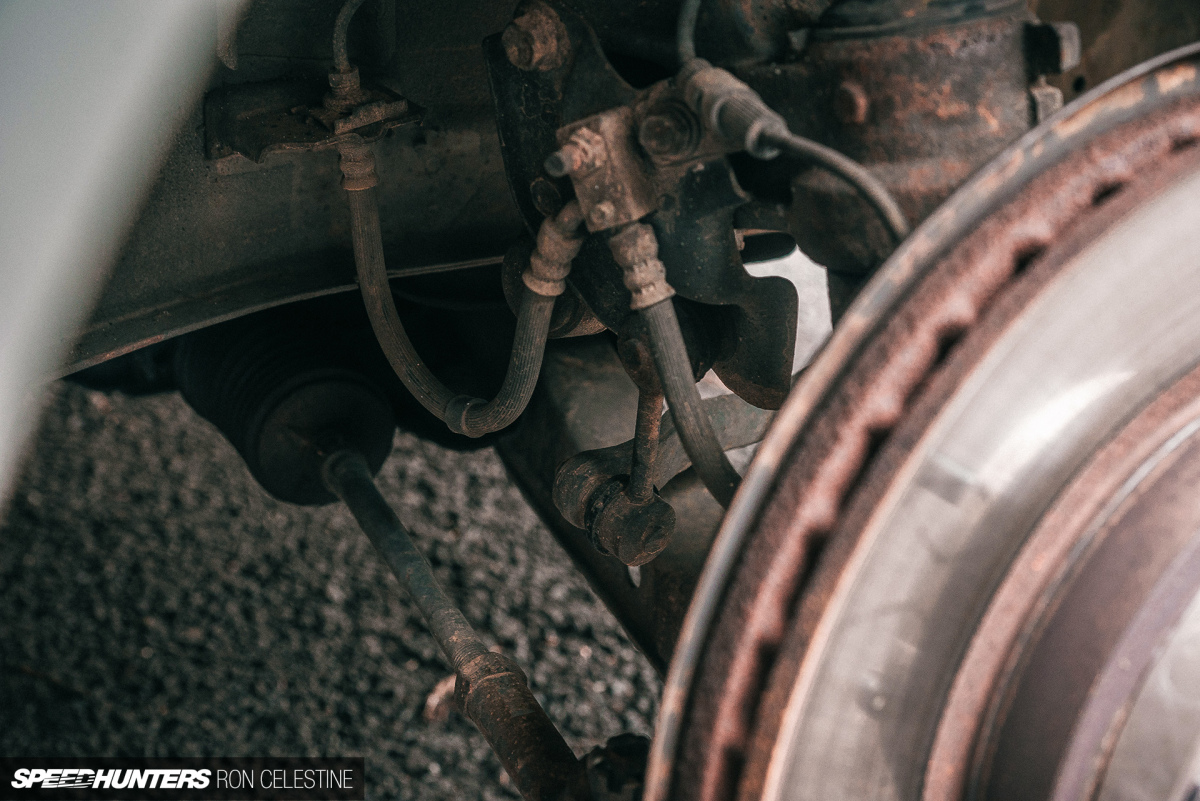
For good measure and a bit more added difficulty, I decided to add adjustable front sway bar end links to the menu, as the ones in the car were likely the originals from 1999. With the ride height far from stock, the chance of preload on the front sway bar was high.
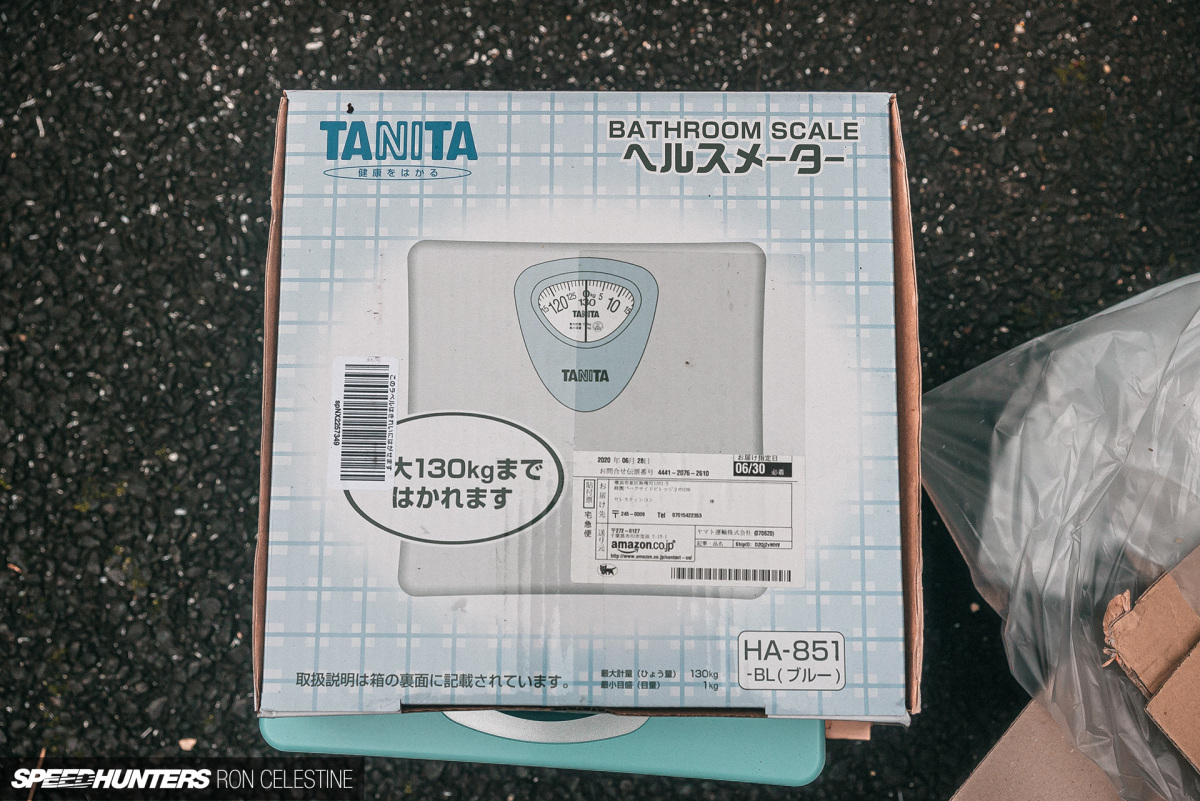
The first step for me was to understand that perfection would be impossible, and that was absolutely fine. It’s not like the car handled poorly before, and this is going to be done with bathroom scales, not specialist equipment. The main trick is to handle the pitfalls as best as possible to give yourself the highest chance of accuracy.

On the subject of scales, I decided to use analog scales versus digital ones. Besides the fact that analog scales are far cheaper (these were around ¥800 yen (US$7.50) each for those keeping track at home), they’d be easier to keep zeroed out over a digital scale that automatically powers off. Since it was going to take some time to jack the car up and get everything positioned correctly, I was afraid the scales might time-out and mess everything up. Simplicity is key here.
These scales max out at 130kg each, but because the 130kg (286lb) limit matches up exactly at the 0kg mark, you could go beyond 130kg and still be OK – to an extent. I discovered this the hard way, but I’ll talk about that later.

The next thing to take into account was the platform height for the scales. You simply can’t have the other three tires on the ground while one corner is lifted up on the scales. Likewise, you can’t have three tires up on platforms, and the one corner dropped on the scales on the ground. Everything needs to be levelled out as much as possible. Since I tend to always have plywood around the house for various DIY projects, I made shims so I could keep everything as level, taking into account the thickness of the 2×4 timber I would be using to transfer the weight across the scales.
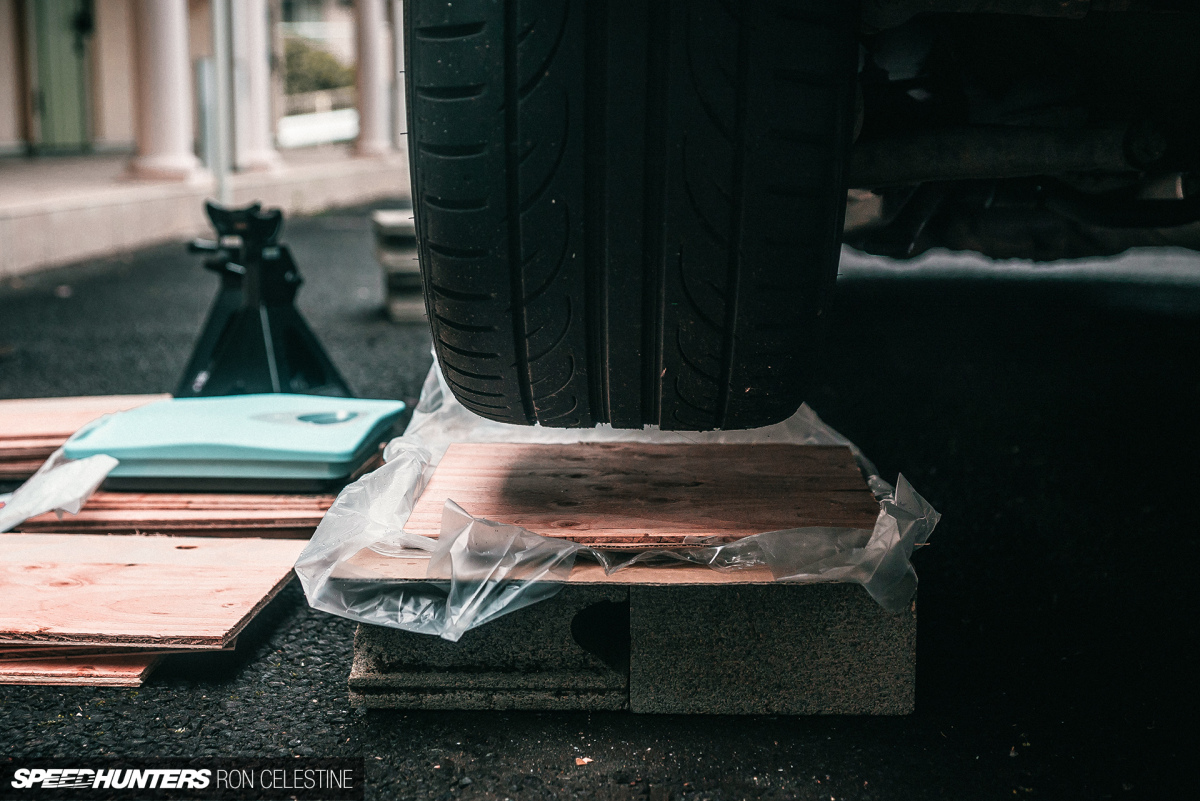
Now it was time to address the bound-up suspension issue that arises when you jack a car up. One way to relax the system is to roll the car back and forth on the platforms, however I figured doing this on bricks would be a bit too reckless, even for me. A safer route would be to create turntables that I could place underneath the tires that would allow the suspension to relax once lowered on them.

A cheap and pretty cost effective way to make these is to sandwich trash bags between cardboard. I added some lube to the mix for extra insurance. The night before, I tested various bags and discovered that you could use regular plastic bags from the supermarket, but the larger plastic bags used for trash gave a better result and thus I went that route. One thing to remember is not only does each platform need to have one of these DIY turntables, but each scale needs one as well.
CHAPTER THREE
Let The Insanity Begin
With each pitfall accounted for the best as possible, it was now time to perform the corner balance circus act.

Before beginning, I disconnected each sway bar end link to ensure that no weight was accidentally transferred via the sway bar, made sure I had roughly half a tank of gas, and simulated my body weight with 83kg of stuff I had around the house.
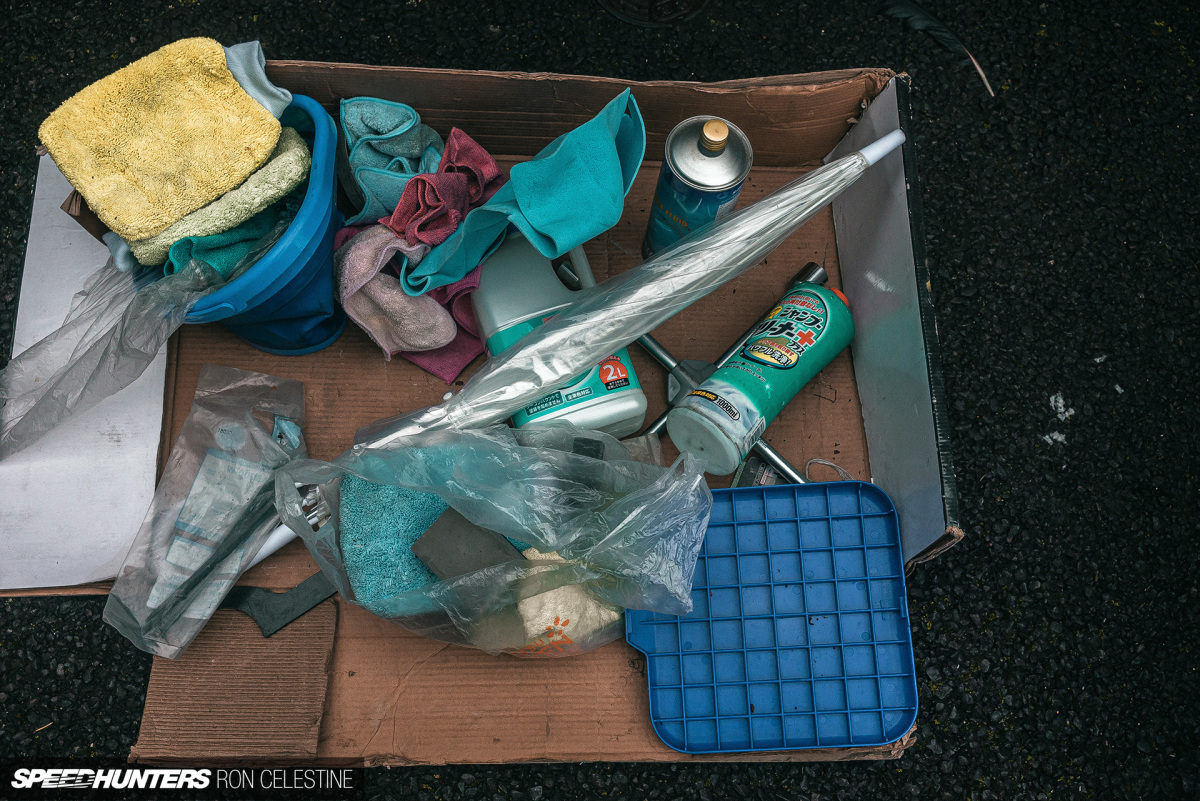


I also took this time to do some spring cleaning and remove the junk that I normally keep in my trunk. Curious, I sat the pile on a scale and was shocked to discover it weighed a little over 5kg.

Starting from the passenger front corner, I worked my way around all four corners, giving the car a good jostle to help the turntables relax the suspension.
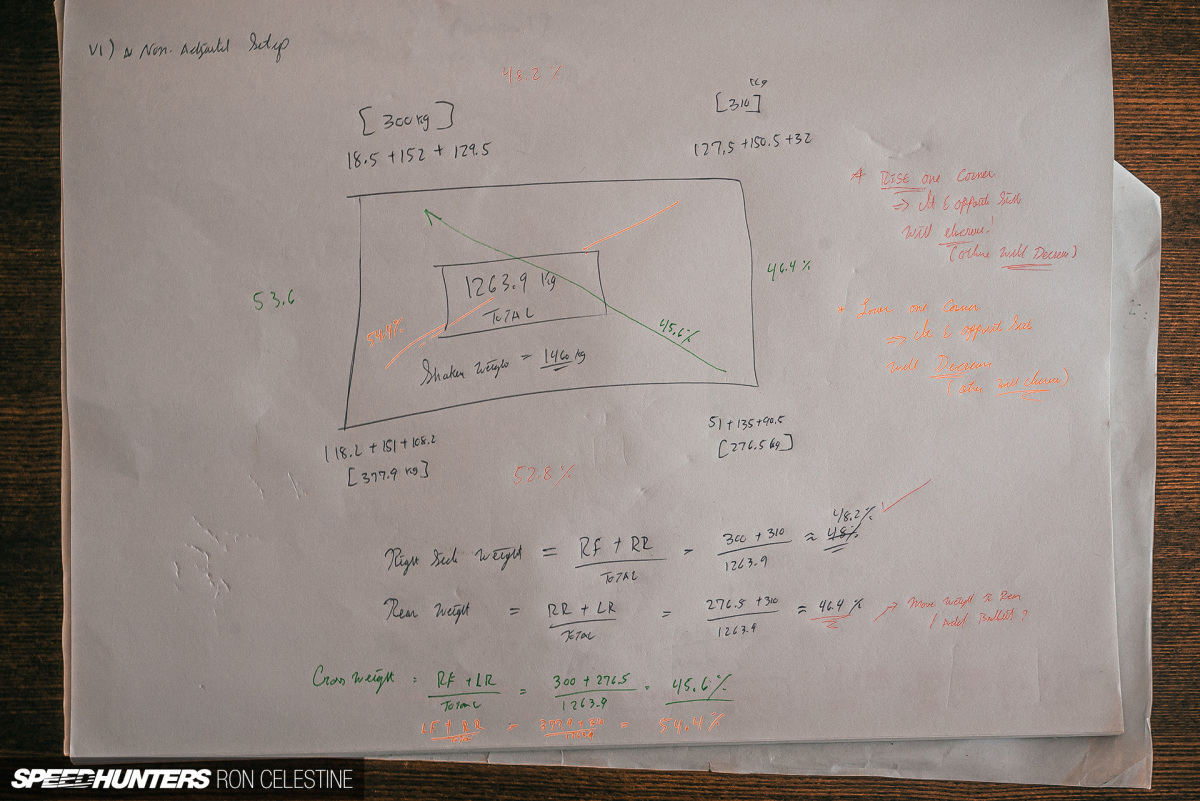
After gathering the data, I drew up this simple diagram to help visualize what was going on. According to shaken data, my car weighed 1,460kg when it left the factory, so I knew my numbers should be close to this.
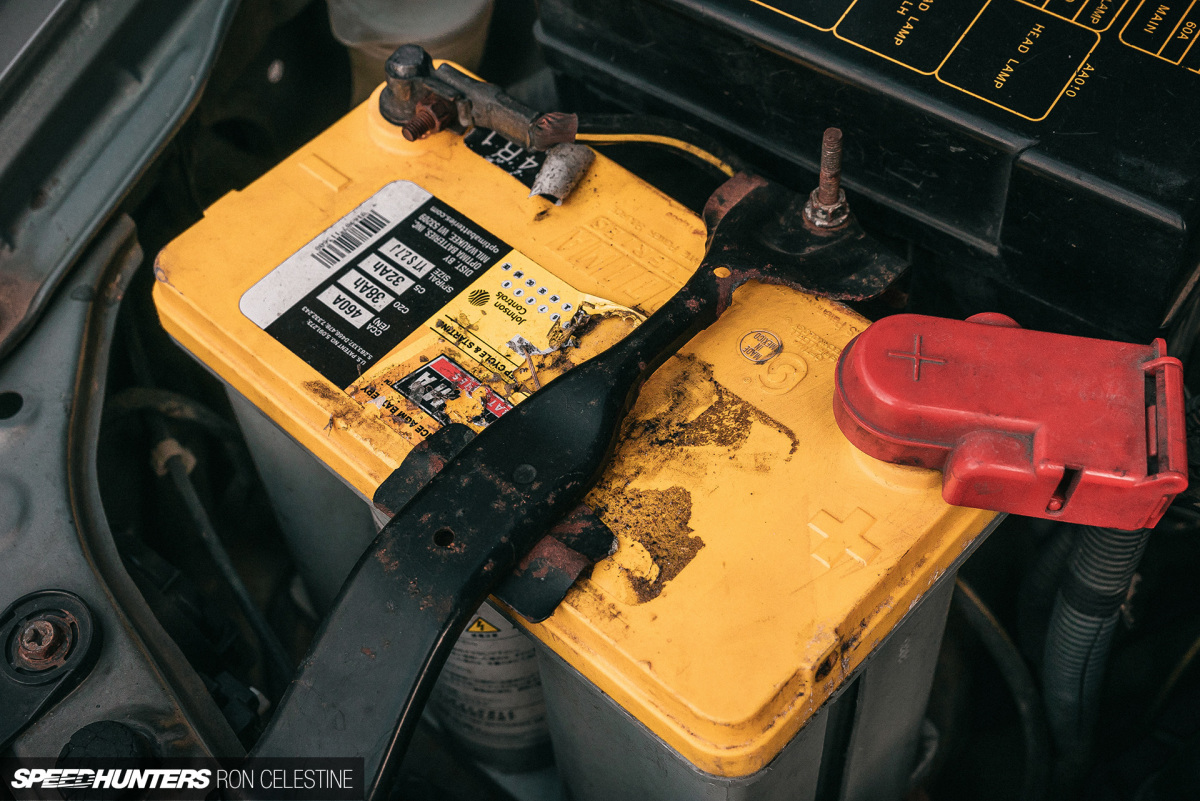
The total weight measured was 1263.9kg – which was 196.1kg off of the shaken number, or a 13% deviation – my first red flag that something was up. Project Rough does have some weight reduction in the form of an FRP hood, lighter battery, lighter wheels, no spare wheel/tire, and a few other things removed, but I couldn’t really justify such a big difference. The second red flag was the side you would expect to be the heaviest – the driver’s side – wasn’t.
I decided to press forward with the calculations to give my brain some time to think what could have happened.
Right Side Weight: 48.2%
Rear Weight: 46.4 %
Cross Weight: 45.6%/54.4%
CHAPTER FOUR
Murphy’s Law
In the back of my mind I knew something was wrong with my test, but I couldn’t pinpoint exactly what could have happened. Looking at the diagram, I decided to try and make an adjustment anyway, to see if that fixed anything. If you lift one corner, you effectively increase the weight at that and the opposite corner, which will decrease the weight at the other corners.

Likewise, if you lower one corner, you effectively decrease the weight at that and the opposite corner. This will also increase the weight at the other corners.

This is where the real time consuming part comes in, as making small changes could have a profound effect on the balance. Keeping a note of where you started and what changes you make is crucial. Looking at my data, I came to the conclusion that I should lift the passenger rear corner. I went in and did so by 5mm to start with, and then rechecked the weight. Knowing the weight is supposed to increase at that newly adjusted corner, I checked it first. The weight dropped.
Remember when I mentioned that if the scale goes beyond 130kg that you would be fine to an extent. That extent is the fact that even though the scale will technically go beyond 130kg, it was never really designed to handle more than its maximum limit. In conclusion, I broke one of the scales which caused it to read incorrectly.

Fortunately, I knew Murphy’s Law was going to strike at some point and had purchased an extra scale just in case. With the broken scale removed from the equation and its replacement in place, I checked the weight at all the corners and made another diagram.
The total weight measured this time around was 1,383kg – or 77kg off the shaken number. A 5.27% deviation, which when I factor the weight-saving changes that I mentioned a moment ago (FRP hood, lighter battery, lighter wheels, no spare wheel/tire) is a totally justifiable number. Another good sign was the fact that the driver’s side was now the heaviest corner, as one would expect. Confident in these figures, I crunched the numbers and came up with:
Right Side Weight: 55.3%
Rear Weight: 45.3 %
Cross Weight: 49.2%/50.8%

Success! I would have liked to get the front-to-rear weight a bit more balanced, but the only way to achieve this is to add ballast, remove weight, or physically move it around. You can’t change the side and rear weight distribution by corner balancing due to the notion that if you change one corner, it affects the opposites directly.

To help improve the balance, a few things I could think of would be moving the battery to the rear, fitting a lighter intercooler, and using less plumbing from the intercooler to the intake, seeing that I’m still running the awful stock RB25DET intake plenum.
CHAPTER FIVE
Links
With the balances as good as it’s going to get for a while, it was time to set up the adjustable end links. Ideally you want to install and set them up when you can simulate your body weight in the car. Since I was playing with the ride height for corner balancing, locking them in afterwards was the perfect timing.
Adjustable end links can be a great addition if you’re looking to improve your handling as they remove any preload on the sway bar. If your bar is already twisted before you come to a corner, it could cause the car to act differently between left and right turns, which isn’t ideal. Not only was I going to be able to zero-out any preload that might be in the system, but the stiffer bushings and stronger material was going to be a nice addition over the OEM links, too.
Installing adjustable end links is pretty straightforward, with the exception of needing to fully lock them in with the vehicle on the ground. This can cause a bit of a problem if your car is lowered and you can’t easily get underneath it, such is the case with Project Rough.

I could have used the brick platform to give me some clearance, but I honestly didn’t want to crawl underneath the car while it was on the bricks unless I absolutely had to.
But there’s another trick, and that’s to simulate the suspension being compressed at ride height using a jack. After making sure the suspension was settled, I measured the distance from the bottom of the fender to the center of the wheel hub. In my case it was roughly 320mm.

After jacking the front up, I measured to see how far the suspension dropped which was roughly 36mm. I placed the jack underneath the control arm and compressed the suspension until it matched my earlier measurements. I made sure I could still barely adjust the height by hand before locking everything down for good.
FINAL CHAPTER
The Verdict
Of course, I should have aligned the car, but I was exhausted by the end of this and wanted to see what changes, if any, Project Rough had experienced. They say corner balancing can make some of the most profound impacts on a car’s handling, and for my ER34 GT-T it absolutely delivered.

The steering feel is remarkable, as the tiniest of inputs cause the car to change direction. Everything feels so composed and up on its toes that it’s hard to believe that a few changes made such a big impact. All of this while running the suspension dampers in what I call ‘normal’ setting, which is the adjustment level I used for daily comfort use.

Even more remarkable – if slightly embarrassing – is the fact that it wasn’t until after I buttoned everything up and test drove that I realized the rear sway bar links were also garbage. While everything felt amazing on my test run, I couldn’t help but notice that the rear seemed to struggle to keep up with the front end’s newfound agility, which was odd as I already have a stiffer sway bar in the rear than the front. I took a look at the rear and that’s when I discovered the bad news. I’ve ordered some adjustable rear end links to replace the worn out OEM ones, and will install them at the same time I do the alignment. That will be for a later story.
Would I recommend corner balancing your car even if you’re not really looking to improve your lap times? Absolutely. If you can bring out the potential in your car without having to spend a ton of money, then why wouldn’t you? Would I recommend this particular method? That’s a harder sell if I’m being honest. Yes, it works, as I demonstrated, but I also was incredibly lucky that I nailed the almost 50/50 cross balance on my first adjustment. Imagine if it was way off and you had to keep shuffling bricks and scales around over and over again. It’s a great workout but it’s also exhausting. And of course, you can always argue that time is money.
What I would recommend is this: If you have some money to spend and you still want to corner balance your car yourself, look for used dedicated scales. You also could pick up a scale that maxes out at 400 to 500kg depending on your car, and just worry about moving one scale around. There are countless ideas out there and I’d be keen to hear some of yours. Let me know in the comments if you’ve corner balanced your car DIY-style, and how did you it.
Ron Celestine
Instagram: celestinephotography
















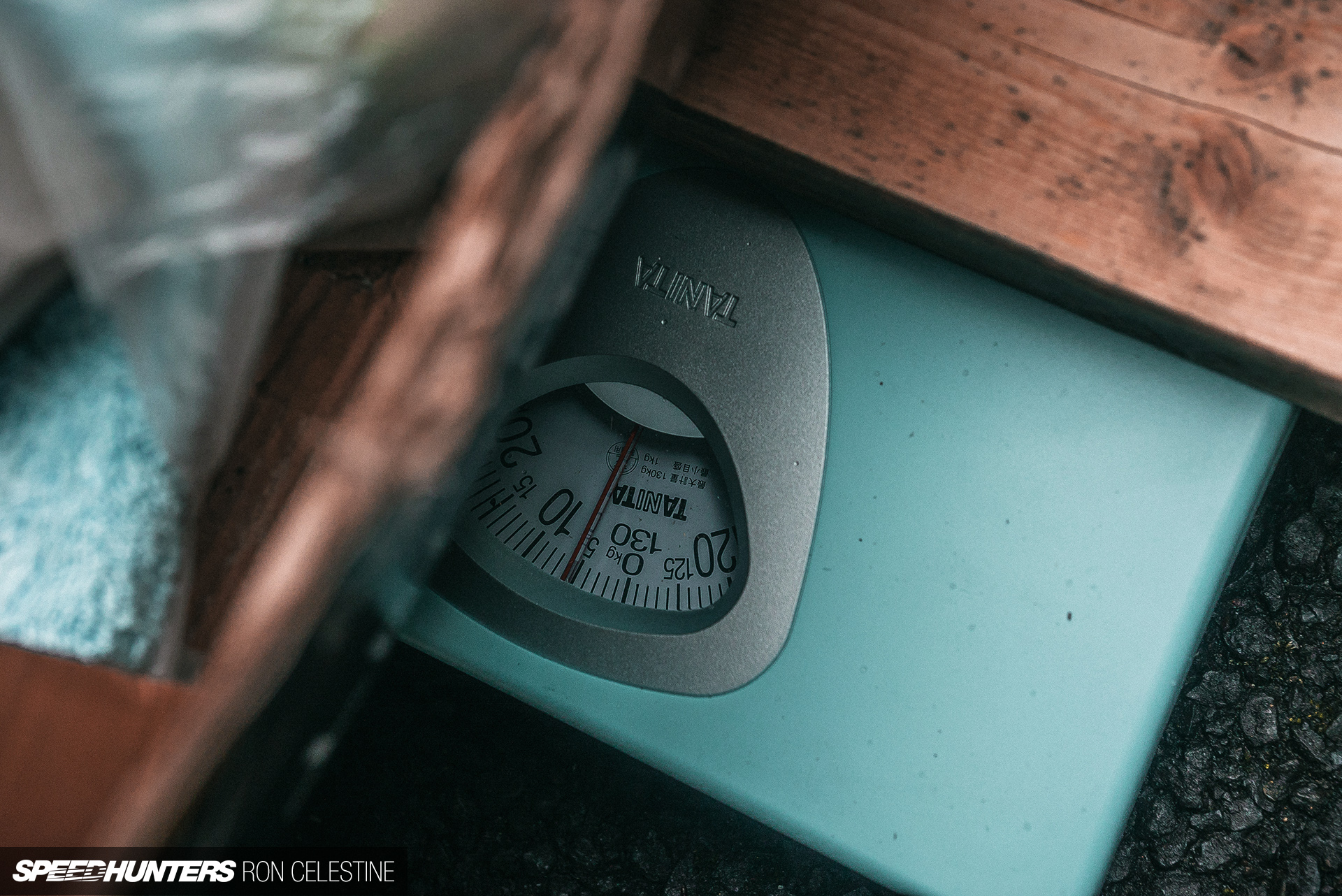
















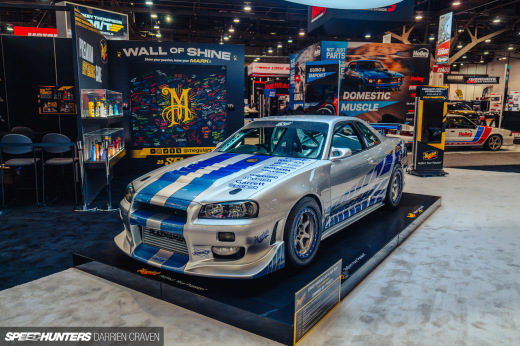






Nice
I am making a good salary from home $1200-$2500/week , which is amazing, under a year back I was jobless in a horrible economy. I thank God every day I was blessed with these instructions and now it's my duty to pay it forward and share it with Everyone, Here For MORE INFO PLEASE Just check this SITE.........http://www.cyberstar1.com
Really enjoy your posts, Ron. Especially everything related to Project Rough is always a bit out of the box and inspires me to try new things out. Tidying up the suspension and bushings on my E46 is on my bucketlist anyways, so I might give your method a try. Just have to find some used scales that are ready for the job. ^^
Hahaha glad I could give you some inspiration regardless how crazy it is!
I once read from Nissan that for cars with FR layout, it is better to have more weight up front instead of a 50:50 static distribution, because "weight will shift to the rear when accelerating out of corners, thus achieving a 50:50 weight distribution while also improving rear tyre grip". I'm no expert about this sort of thing, but it sure sounds about right. However, this analogy was found in the brochure of the 370Z, so I do not know if it works the same way on cars with longer wheelbase.
When the 350Z came out, Best Motoring had a Nissan engineer say that as well. That car had a 53:47 distribution so it' supposed to be neutral on acceleration like you said, and the little extra weight at the front when braking would help turn in.
On the other hand, having more static weight at the rear (engine at the back) should be neutral under braking.
While that sounds very logical, why would bmw (kind the the grand master of rwd) make all their cars 50/50?
Hmm i dont know if thats the case anymore, it used to be that the weight of the engine in the older models was distributed 50:50 over the wheels for better handling performance (i own a E28) i dont think this applies to all the vehicles and in the context of total weight distribution.
Yes that isnt the case anymore. My e92 m3 is 52/48
Ghetto Balancing (needs friend)
1: Park car.
2: Measure from center of wheel to the edge of fender well lip.
3: Sit in car
4: Have friend re-measure to see how your weight has moved the car.
5: Do maths. (for example) Therefore if the front-right drops .5in and was 1.5in unloaded then adjust coilovers to 2in.
6: Repeat at all corners.
This now means when you get in the car, it will be at the correct ride height and balanced.
Hahahaha that is pretty clever. That takes out the fun of knowing how much weight is on each corner tho! I did that for my rear end links the other day
A good cheap way to level the scales to a high degree is with a scanning laser level, which most all of the major construction tool manufacturers sell. You can a low-grade Bosch for less than $75 USD, and an off-brand for probably less; all you need is a horizontal line laser or cross laser (only need a single horizontal line). They do all the leveling internally, so you can just plonk the laser on some object, switch it on, and get to work.
It may help to do at twilight/dark for better laser contrast if outdoors, as most of the cheaper lasers are only bright enough for indoor use.
You put the laser at some arbitrary distance in front where the car would be (doesn't matter) and put in on some object of whatever arbitrary height (doesn't matter), and the laser shines a leveled line. Put a rule (or square, etc) vertically on a scale pad. Measure the vertical height from the scale pad to where the laser line hits the rule. Easy.
The actual vertical distance doesn't matter at all, you just want that distance to be the same on all 4 scales. Find the highest scale (smallest vertical distance to the laser line, obviously), and then shim the other 3 to match the same distance-to-laser.
Using a builder's laser is the consumer-grade version of how scales pads are often leveled in pit garages during garage setup. You would also put a bubble level or inclinometer (digital level) on the scale pad as well, and shim edges/corners of each scale such that the scales are not tilted out-of-plane.
I thought about using a laser level to get the scales just right, but then I remembered I'm using bathroom scales lol. Def would do this is I was using better scales / proper scales
So the next time I get pulled over for driving without a fender, I can tell the cop I'm actually trying to balance the car out.
Cool.
This looks fun!
If you're like me and have a crazy sense of fun then yes, it was ^^
Why anybody whouldneed 50:50 is beyond me though? Left to right is a good idea. Front to back not so much. And there isn't an ideal setting for it either. I truly is a matter of driving preference to get the right balance you need. And most of the time that won't be 50/50. Rally cars tend to loaded way more up front copaired to in the back. F1 cars are mostly back loaded. to help with traction.
It's also a matter of preference if you want to do balancing with or without balast weight of a driver. My own reference is to it without. I find driving feeling weird if do it with my own weight compensated for. It's also the most variable weight inside the whole car. Apart from the fuel tank offcourse.
So for me:
Left to right 50:50 : Yes!
But without driver compensation
Front to back 50:50: No!
And not even close to it either. I would lose a couple of seconds per lap thanks to balances issues which reduce cornering speed.
The act of corner weighting is to make sure that when driving you are able to realise the grip potential of the tyres. By loading one more than the others caps the load it can take due to cornering, you're handicapping yourself before you begin.
It's the balance of weight diagonally across the car and is concerned with weight shift during corner. It's not the front/rear balance as that can only be achieved by physically moving mass inside the car to a new location; like moving the battery.
Not really:
Front and rear weight balance can be altered not only by where you have the weight located, but also by lowering or raising your car. I for one use a heavy front balance, so the car rotates easier. Getting a 50:50 distribution will prevent cornering speed inmensely.
And don't get me wrong: On a car with a square footprint and exactly the same setup all around that is the case (diagonal). But since when is a car equally setup front and back? It isn't. So that theory only applies in a fantasy world. The same goes for capping a tyre. Sure that can happen, but in real life you would rarely achieve that with 50:50 distribution. You drive, therefore you move, therefore you shift weight. It would be applicable only on a car that has active aero and active damping for it to work that way.
Why would you do the weight distribution without the driver? When driving, you need to account for the drivers weight as well, right? Since it will have (a slight) effect on the distribution of the total weight. Otherwise, you'll upset your balance again. Or is this a matter of fine-tuning after some seat time?
I'm just wondering since it doesn't make sense in my head.
You say you've lost seconds per lap, but which car do you run and around which distribution front to back?
Think of it as fuel tank. A driver is essentially meat,bones, and water. The problem with water, is that it evaporates. The other fact is that your body moves inside the car, and so are the fluids inside of you. But the main reason in my case, is that my car is road registered, and when doing rally, I have a codriver on board. So setting it u for a driver would have a detrimental effect.
The other problem you have is with your own weight itself. You don''t always weight the same. Not a big deal for a raceteam. For an amateur that would be a big concern, as it needs to happen over and over again. And especially on the road: You will load the car up with family and friend, stuff, etc.
I'm driving a Fiat 127 mk1 as a daily and rally car, which I also do the occasional track day with. So FWD, About 50:50 left to right 65:35 front to back. I have a staggered set of tyres front biased: and softer front spring and harder rear springs. and a front biased rake.
I think it's actually what you said. It's a matter of preference in regards to the balance.
I was pretty curious to see how it would handle with a 50/50 weight distribution front / rear but as it is now (replaced the rear end links already), it handles mega.
I believe it would feel slightly off if I didn't compensate for my weight. Though it is a variable, my weight doesn't fluctuate enough where I'd be concerned if it wasn't EXACTLY the same as when I measured it.
But like your said, it's all about preference.
Suspension tuning is all about balance and preference. Thats why 2 F1 cars of the same team drive differently. Let alone cars from different team's. But the most important part is that corner weighting is just one piece of the puzzle when your talking about suspension. It mainly done to eek out the last bit of performance. But it first comes down to springrate and damping. And different springrates and different damper settings always require a different balance. There is no real sugestion on what to do, but 50:50 is the starting point though. From there on out you just evolve.
Thats why I hate stereo systems in cars. They keep you disconnected from actually observing the car in proper way, and thinking about the next evolution and what you and your car need.
That being said though: I do like your way of out of the box thinking, with the regular scales and your take on carbon parts. Simple thing you can do is make sure the car is on level ground, measure the ride height t the rear on bothe sides. Then make the suspension 1cm higher on both sides. Sould not alter side to side weight balance, but wil alter front to back. The more weight up front, the easier it is to rotate a car. Get a quit roundabout and stay on it for minuted and you'll feel it. Easiest way to get more over or understeer. Once you happy, cornerweight the car and your good to go with what you currently have.
And always remember: It's not about the money you spend on something, it's the amount of your own time you invest in it that really pays of in the end if you are willing to experiment.
ugly car no tfsi.
Another great instalment of Project Rough! I really enjoy these - so much more interesting than a 'build' that has just had budget and parts thrown at it. Corner weighting is one of the things I really want to do with my own project after being blown away by how big a difference a proper alignment made.
All these posts are a cry for help.
Speedhunters dot com, can you PLEASE pay this guy more.?.?.?
Lol not the triple face palm